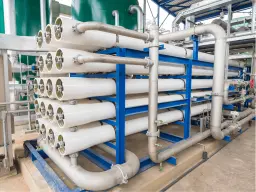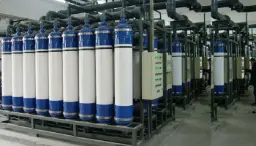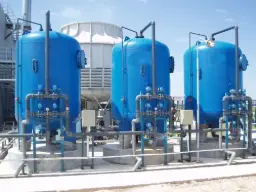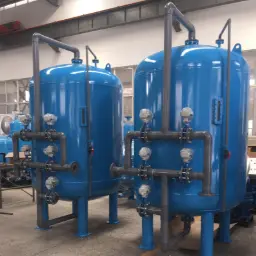Process Water Treatment for Pulp and Paper Industry
The pulp and paper industry is among the most water-intensive manufacturing sectors, consuming thousands of cubic metres per day for wood preparation, pulping, bleaching, paper forming, and finishing. Each of these stages generates distinct side-streams that contain fibres, lignin, resin acids, carbohydrates, bleaching agents, and a variety of inorganic salts. Left untreated, these contaminants quickly foul process equipment, elevate operating costs, and pose serious environmental risks once discharged. Tightening discharge permits, rising freshwater tariffs, and corporate sustainability targets all drive mills to optimise every litre that enters and leaves the plant boundary.
Water quality directly affects pulp brightness, sheet strength, machine runnability, and chemical consumption in sizing and coating. Even subtle fluctuations in conductivity or microbial activity can lead to slime deposits that reduce machine speed, or to pitch agglomerates that cause costly sheet breaks. Robust Pulp and Paper Process Water Treatment therefore becomes a strategic lever for enhancing product quality, reducing downtime, and achieving closed-loop water balances. Modern mills integrate primary clarification, dissolved air flotation, membrane separation, and advanced oxidation so that clarified, stripped, and polished water can safely circulate multiple times before eventual blowdown. Data-driven control of these unit operations ensures consistent key performance indicators such as <50 NTU turbidity to the headbox and <100 µS cm⁻¹ conductivity to the high-pressure showers, safeguarding both profitability and compliance.
Water Treatment Systems Used
Effective water conditioning in a pulp and paper mill relies on an orchestrated series of technologies that each target specific contaminants and flow regimes. A well-designed treatment train begins with coarse separation to capture bark and knots, then progressively removes colloids, colour, and dissolved organics before polishing to boiler or process specifications. The selection and sizing of these systems must account for wide swings in fibre furnish, seasonal temperature changes, and the mill’s desired water reuse ratio. Continuous online monitoring coupled with advanced process control platforms allows operators to modulate chemical dosing, flow balance, and cleaning cycles in real time. With digital twins and predictive analytics becoming mainstream, treatment assets are no longer isolated utilities but integral nodes in the mill’s overall production optimisation strategy.

Reverse Osmosis
Lowers conductivity, hardness, and silica for boiler feed or high-pressure shower circuits, typically producing permeate with <10 µS cm⁻¹ conductivity.

Ultrafiltration
Provides a physical barrier against high-molecular-weight organics and pathogens, enabling 90 % reuse of white water in low-conductivity applications.

Multimedia Filters
Uses graded anthracite, sand, and garnet layers to polish clarified effluent, targeting <5 NTU turbidity to protect fine-pore UF membranes and spray nozzles.

Dissolved Air Flotation (DAF)
Captures resinous pitch, fibres, and lignin colloids through micro-bubble attachment, achieving <20 mg L⁻¹ TSS that is suitable for membrane pretreatment.
These technologies form a complementary barrier chain that incrementally removes suspended, colloidal, and dissolved impurities while minimising chemical consumption and sludge volumes. Primary clarification and DAF tackle the bulk solids economically, filters safeguard membranes, and UF-RO pairs deliver high-purity water for critical operations. The AOP step provides a polishing safety net for hard-to-biodegrade compounds, aligning treated effluent quality with corporate sustainability goals. By integrating flow equalisation, automated backwashing, and condition-based cleaning regimes, mills secure high uptime, reduce fresh-water intake, and generate consistent fibre and chemical yields that translate directly into lower cost per tonne of finished paper.
Key Water-Quality Parameters Monitored
Maintaining stable water chemistry across pulp washing, bleaching, and paper-machine sections requires a disciplined monitoring programme. Operators track dozens of variables, yet a handful carry disproportionate weight in predicting process stability and product quality. Turbidity serves as a surrogate for fines and colloidal pitch that can foul forming fabrics, while true colour and chemical oxygen demand (COD) reflect the bleaching load and lignin residuals circulating in closed loops. Conductivity signals the mineral salt build-up that can lead to scaling on heater surfaces or interfere with retention aids. Total organic carbon (TOC) offers an aggregate measure of extractives and degraded hemicellulose that can trigger biofilms if left unchecked.
Equally important are microbiological indicators such as adenosine triphosphate (ATP) levels and heterotrophic plate counts, which guide the dosing of biocides and the scheduling of boil-outs. Silica is monitored whenever RO permeate feeds high-pressure boilers, because polymerised silica deposits are notoriously difficult to remove once formed. Manganese and iron, often leached from process equipment, can catalyse peroxide decomposition in the bleach plant, forcing higher chemical consumption. By coupling these online metrics with predictive models, mills can anticipate excursions, fine-tune coagulant addition, and coordinate Clean-In-Place cycles before fouling compromises throughput.
| Parameter | Typical Range | Control Method |
|---|---|---|
| Turbidity | 0-5 NTU to filters, <1 NTU to UF | Polymer coagulant trim and filter backwash optimisation |
| Conductivity | 100-1 500 µS cm⁻¹ process, <50 µS cm⁻¹ boiler feed | RO recovery adjustment and neutral salt purge |
| Colour (Pt-Co) | 20-300 units | AOP intensity set-point modulation |
| TOC | 5-50 mg L⁻¹ | UF flux control and biocide dosing |
| Silica | <10 mg L⁻¹ to RO, <0.1 mg L⁻¹ to boiler | Lime softening or ion exchange guard bed |
Table 1 – Critical water-quality parameters for pulp and paper mills and typical control strategies.
The interplay of these parameters determines not only regulatory compliance but also energy efficiency, fibre yield, and machine availability. Rising TOC often precedes bio-slime outbreaks, allowing proactive shock dosing. Conductivity trending offers insight into evaporator blowdown requirements, while parallel ATP and turbidity signals highlight the precise onset of membrane fouling. Integrating such multi-variate data streams into a single dashboard empowers mill engineers to optimise operating windows rather than chase alarms, resulting in smoother startups, fewer sheet breaks, and measurable reductions in specific water consumption.
Design & Implementation Considerations
Translating water-quality targets into an engineered solution begins with a mass balance that maps every intake, bleed, and recycle flow throughout the mill. Designers validate these data against historical production swings and fibre recipes to size equalisation basins and surge tanks that dampen hydraulic peaks. Material selection is equally meticulous: stainless steel 316L is standard for bleaching filtrate loops rich in chloride, while duplex alloys defend RO concentrate headers from stress-corrosion cracking. High-density polyethylene (HDPE) piping often suffices for low-pressure white-water circuits, saving cost without sacrificing durability.
Process and instrumentation diagrams (P&IDs) feature redundancy in critical valves, differential-pressure transmitters across membranes, and strategically placed sampling ports that feed laboratory confirmation of online sensors. Variable-frequency drives on transfer pumps deliver precise flow control and lower energy use, while programmable logic controllers integrate with mill-wide DCS systems for seamless alarm management. Designers align specifications with ISO 22000 for hygienic design and NSF/ANSI 61 for potable water components when high-pressure shower lines risk aerosol exposure to operators. Where wastewater is discharged to sensitive aquatic environments, WHO effluent guidelines and local EPA colour limits further shape reactor residence times and oxidant dosages. Cyber-secure SCADA architectures ensure that treatment assets remain resilient against remote intrusion, a rising concern as mills digitise auxiliary utilities.
Operation & Maintenance
Long-term reliability hinges on disciplined preventive maintenance that goes beyond generic OEM checklists. Daily routines include visual inspection of clarifier skimmer chains, verification of polymer aging times, and ultrasonic thickness gauging of DAF saturator nozzles. Weekly tasks cover filter media head-loss trending and ATP bioluminescence swabbing in splash zones prone to biofilm. Membrane systems follow clean-in-place (CIP) protocols triggered by 10-15 % normalised flux decline, alternating alkaline surfactant, acidic chelant, and enzymatic soaks to dislodge organic, inorganic, and biological foulants respectively.
Spare-parts strategy categorises items into critical (e.g., RO high-pressure pump thrust bearings) and consumable (e.g., filter cloths). Critical spares reside on site with bar-code tracking, while consumables are sourced via vendor-managed inventory to avoid over-capitalisation. Operator competencies now extend to interpreting spectrophotometric colour curves and performing trend analytics in modern CMMS platforms. Cross-training between treatment and paper-machine crews fosters holistic decision-making; for instance, knowing when to adjust white-water polymer rather than over-cleaning UF modules. Annual shutdowns feature pipe-pigging campaigns, flow-balance recalibration, and PLC firmware updates, ensuring the treatment plant keeps pace with incremental production debottlenecking.
Challenges & Solutions
Persistent scaling arises when evaporator concentrate is repurposed for dilution showers without adequate RO bypass control. Mills mitigate this by implementing antiscalant dosing based on saturation index modelling and by sequencing membrane stages to operate at lower recovery during hardwood campaigns with high silica. Bio-fouling remains endemic in warm climates, where seasonal river water introduces spores that flourish in stock chests. A modern remedy pairs real-time ATP detection with peracetic acid injections timed to production lulls, minimising sheet odour complaints. Regulatory pressure around adsorbable organic halides (AOX) can restrict bleach filtrate recycling; advanced oxidation with UV/H₂O₂ followed by granular activated carbon polishing consistently delivers AOX below 0.1 kg t⁻¹ pulp, satisfying most directives.
- Scaling on heat-exchanger bundles – Controlled via dynamic antiscalant feed linked to Langelier Saturation Index and by blending high-purity permeate for dilution water.
- Bio-slime on forming fabrics – Overcome using UV-enhanced biologically active filters that suppress bacterial ingress, complemented by shock biocide pulses triggered by ATP spikes.
- Colour excursions in final effluent – Resolved through tertiary ozonation and manganese-catalysed peroxide which oxidise chromophores without raising AOX.
Advantages & Disadvantages
While no treatment strategy is universally perfect, understanding trade-offs helps decision-makers align capital budgets with risk tolerance and sustainability goals. Deploying high-recovery RO, for example, slashes fresh-water intake but demands vigilant scaling control and energy consumption that can be partially offset with variable-speed drives. Conversely, relying on clarification alone lowers operating complexity but limits water reuse and may fail future discharge revisions. Transparent evaluation of lifecycle cost, carbon footprint, and production flexibility aids in selecting the optimal configuration for each mill.
| Advantage | Disadvantage |
|---|---|
| Substantial reduction in freshwater withdrawal (up to 80 %) | Higher capital expenditure for membranes and automation |
| Improved pulp brightness and sheet strength from consistent water quality | Energy demand increases, especially at high-pressure RO stages |
| Lower chemical and biocide usage due to targeted contaminant removal | Requires specialised operators and analytical instruments |
| Compliance with stringent colour and AOX limits | Periodic downtime for membrane cleaning and media replacement |
Frequently Asked Questions
Q1: How often should RO membranes be cleaned in a pulp and paper application?
A1: Typical mills schedule chemical cleaning when normalised permeate flux drops by 10 % or when salt rejection declines by 2 %, translating to every 6-12 weeks depending on feed quality and antiscalant efficiency.
Q2: Can DAF sludge be repulped and returned to the process?
A2: Yes, many mills thicken DAF skim to 4-6 % solids and blend it into low-consistency storage towers, recovering fibres and reducing landfill fees.
Q3: What is the preferred biocide for warm-climate mills prone to bio-slime?
A3: Oxidising biocides like peracetic acid are favoured because they decompose to benign by-products and maintain efficacy across varying pH.
Q4: How is colour monitored in real time?
A4: Inline UV-Vis spectrophotometers correlate absorbance at 455 nm to Pt-Co colour units, enabling closed-loop peroxide or ozone dosing.
Q5: Do membrane processes remove dissolved gases like oxygen?
A5: RO lowers dissolved oxygen modestly, but vacuum degasifiers or membrane contactors are installed when low-O₂ boiler feed is critical.
Q6: What international standards guide mill water safety?
A6: ISO 22000 covers hygienic design, while NSF/ANSI 61 certifies materials. Local EPA regulations dictate effluent parameters, and EN 12255 informs biological treatment stages.
Q7: How can digital twins assist treatment optimisation?
A7: A calibrated twin predicts fouling rates, scales CIP frequency, and evaluates what-if scenarios, thereby trimming energy consumption and extending asset life.